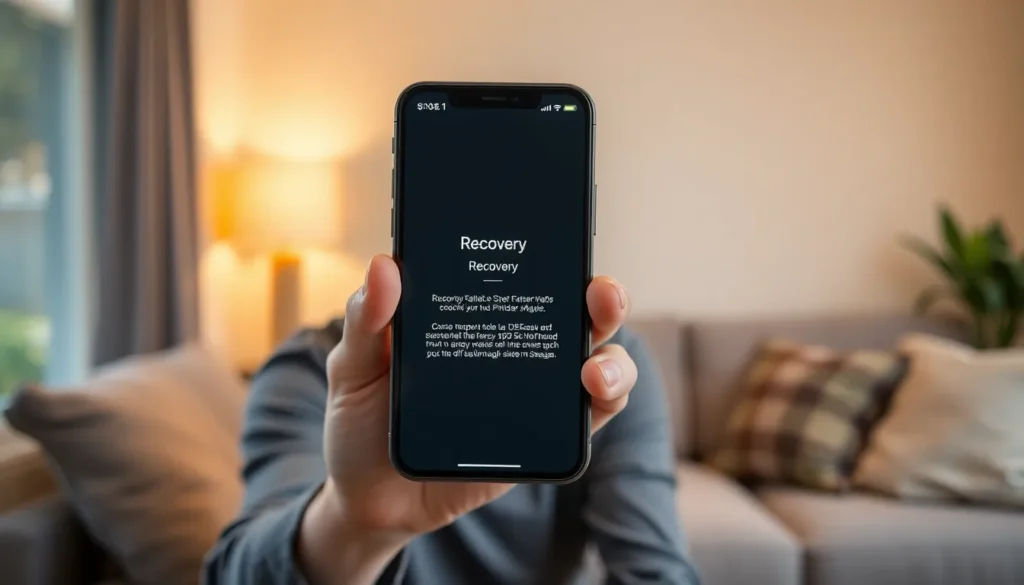Table of Contents
ToggleEver found yourself staring at a frozen iPhone screen, wondering if your device has decided to join a secret society of stubborn gadgets? Fear not! Restoring your iPhone without iTunes in recovery mode is not only possible but can be done for free. Imagine a world where you don’t have to deal with the complexities of iTunes or the dreaded error messages that pop up like unwelcome party guests.
Understanding iPhone Recovery Mode
Recovery Mode is a special state for iPhones that allows users to troubleshoot issues. This mode provides access to restore or update software settings when devices become unresponsive.
What Is Recovery Mode?
Recovery Mode operates as a diagnostic tool for iPhones. It allows for entering a state where the device can communicate with computers without booting the operating system. Users can access it by pressing specific buttons on the device. Typically, this involves pressing the right buttons in sequence until the recovery screen appears. The recovery screen displays options for restoring or updating the device, making it easier to address software problems.
When to Use Recovery Mode?
Users should utilize Recovery Mode in specific scenarios. When an iPhone is stuck on the Apple logo, Recovery Mode helps resolve the issue. It’s essential when software updates fail or devices encounter persistent errors. Situations of activation lock or being unable to restore with regular methods also require entering this mode. Activating Recovery Mode can lead to successful resolutions that standard troubleshooting cannot achieve.
Alternatives to iTunes for iPhone Restoration

Several alternatives exist for users looking to restore an iPhone without using iTunes. These options often simplify the process and reduce frustrations associated with traditional methods.
Third-Party Software Solutions
Numerous third-party software options provide seamless restoration experiences. Tools like Tenorshare ReiBoot, Dr.Fone, and iMyFone Fixppo enable users to restore iPhones from Recovery Mode effectively. Each tool offers a user-friendly interface, ensuring that even those with minimal technical experience can navigate the restoration process. Additionally, many of these solutions support various iOS issues, making them versatile choices for users. Some programs come with free trial versions, allowing users to test functionality before purchasing.
Built-In Apple Tools
Apple offers built-in tools that can assist in restoring an iPhone without requiring iTunes. The Finder app on macOS Catalina and newer versions allows straightforward device management, including restoration tasks. iCloud provides another option for users who have backed up their devices; restoring data and settings becomes easy with just a few clicks. Using these tools simplifies the process, making it more accessible for users familiar with the Apple ecosystem.
Step-by-Step Guide to Restore iPhone Without iTunes
Restoring an iPhone without iTunes involves specific steps that users can follow to ensure a smooth process. Below are the detailed procedures.
Preparing Your iPhone
Before starting the restoration process, confirm that the iPhone has sufficient battery life. A minimum of 50% battery is essential to avoid interruptions. Users must also back up important data, as restoring might erase existing files. Connecting the iPhone to a stable Wi-Fi network facilitates any necessary downloads during restoration. Keeping the iPhone updated with the latest iOS can help minimize potential compatibility issues.
Entering Recovery Mode
Entering Recovery Mode requires users to follow a sequence of button presses based on the iPhone model. For iPhone 8 and later, quickly press the Volume Up button, then the Volume Down button, and then press and hold the Side button until the recovery mode screen appears. For iPhone 7 and 7 Plus, press and hold both the Volume Down and the Side button until the recovery mode screen emerges. For iPhone 6s and earlier, press and hold both the Home and the Top (or Side) button. Upon successful entry, the iTunes or Finder screen will indicate the readiness for restoration.
Restoring Your iPhone Using Alternative Methods
Alternative methods for restoring an iPhone include using third-party software or built-in Apple tools. Programs like Tenorshare ReiBoot and Dr.Fone provide user-friendly interfaces for straightforward restoration from Recovery Mode. Free trials often allow users to gauge the software’s capability before deciding on a purchase. Within the Apple ecosystem, the Finder app on macOS Catalina or newer serves as a convenient management tool for restoring devices. Users with iCloud-enabled backups can effortlessly restore data and settings, offering a hassle-free recovery option.
Tips for a Successful Restoration
Restoring an iPhone without iTunes requires careful consideration. Prioritizing the following tips can enhance your chances of a successful process.
Backup Your Data
Backing up data before starting the restoration process is critical. Utilize iCloud to store essential files and settings, ensuring you can retrieve them later. Alternatively, consider using third-party software that offers backup features, allowing you to save data conveniently. Keep in mind that users should confirm backups are complete before proceeding. Data loss can be devastating, so it’s better to be safe.
Troubleshooting Common Issues
Encountering issues during restoration is common. Users often face problems such as software incompatibility or errors in Recovery Mode. To address software incompatibility, ensure the third-party tool is compatible with the iOS version installed on the device. Clearing cache or restarting the device might resolve unexpected errors. If Recovery Mode fails, try repeating the button sequence or using a different USB cable. Staying calm and methodical can result in a smoother restoration experience.
Restoring an iPhone without iTunes in Recovery Mode offers a practical solution for users facing device issues. By utilizing user-friendly alternatives and built-in Apple tools, individuals can navigate the restoration process with ease. It’s crucial to remember the importance of backing up data to avoid potential loss.
With the right preparation and knowledge, restoring an unresponsive iPhone becomes a manageable task. Users can confidently tackle software-related problems, ensuring their devices return to optimal performance. Embracing these methods not only saves time but also enhances the overall user experience within the Apple ecosystem.




